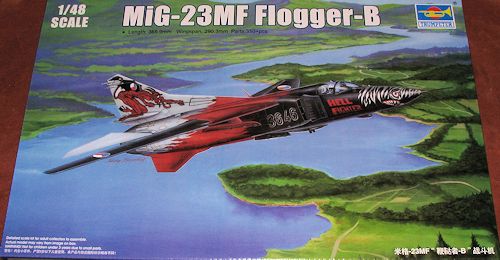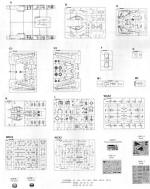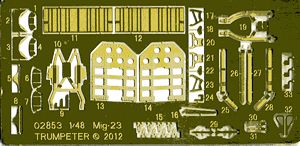
| KIT #: | 02854 |
| PRICE: | $26.99 on sale ($56.00 SRP) |
| DECALS: | Three options |
| REVIEWER: | Scott Van Aken |
| NOTES: | Includes photo etch fret |

| HISTORY |
The Mikoyan-Gurevich MiG-23 (Russian:Микоян и Гуревич МиГ-23;NATO reporting name: Flogger) is avariable-geometryfighter aircraft, designed by theMikoyan-Gurevich design bureau in the Soviet Union. It is considered to belong to the Sovietthird generation jet fighter category, along with similarly aged Soviet fighters such as theMiG-25 "Foxbat". It was the first attempt by the Soviet Union to designlook-down/shoot-down radar and one of the first to be armed withbeyond visual range missiles, and the first MiG production fighter aircraft to have intakes at the sides of the fuselage. Production started in 1970 and reached large numbers with over 5,000 aircraft built. Today the MiG-23 remains in limited service with various export customers.
The MiG-23 MF (Flogger B), was an export derivative of the MiG-23M originally intended to be exported to Warsaw Pact countries, but it was also sold to many other allies and clients, as most export customers were dissatisfied with the rather primitive MiG-23MS. It actually came in two versions. The first one was sold to Warsaw Pact allies, and it was essentially identical to Soviet MiG-23M, with small changes in"identify friend or foe" (IFF)transponders and communications equipment. The second variant was sold outsideEastern Europe and it had a different IFF and communications suite (usually with the datalink removed), and downgraded radar, which lacked theelectronic counter-countermeasure (ECCM) features and modes of the baseline "High Lark". This variant was more popular abroad than the MiG-23MS and considerable numbers were exported, especially to the Middle East.
The infrared system had a detection range of around 30 km against high-flying bombers, but less for fighter-sized targets. The aircraft was also equipped with a Lasur-SMA datalink. The standard armament consisted of two radar- or infrared-guidedVympel R-23 (NATO: AA-7 "Apex") BVR missiles and twoMolniya R-60 (NATO: AA-8 "Aphid") short-ranged infrared missiles. From 1974 onwards, double pylons were installed for the R-60s, enabling up to four missiles to be carried. Bombs, rockets and missiles could be carried for ground attack. Later, compatibility for the radio-guidedKh-23 (NATO: AS-7 "Kerry") ground-attack missile was added. Most Soviet MiGs were also wired to carry tactical nuclear weapons. Some 1300 MiG-23Ms were produced for the VVS andSoviet Air Defense Forces (PVO Strany) between 1972 and 1978. It was the most important Soviet fighter type from the mid-to-late 1970s.
| THE KIT |
 This is, I believe, at least the second boxing of the MiG-23 and like most modern jet kits in this scale, is actually quite detailed. The cockpit comes with a very convincing bang seat that has a p.e. harness. The tub includes nicely raised detail with a decal also available to place on the consoles and instrument panel. A stick, and rudder pedals make for a convincing 'office'. There are also cockpit side panels to place on the interior, these having decals as well.
This is, I believe, at least the second boxing of the MiG-23 and like most modern jet kits in this scale, is actually quite detailed. The cockpit comes with a very convincing bang seat that has a p.e. harness. The tub includes nicely raised detail with a decal also available to place on the consoles and instrument panel. A stick, and rudder pedals make for a convincing 'office'. There are also cockpit side panels to place on the interior, these having decals as well.
The fuselage is in two halves so any two seater to be done will have to have a new mold fuselage. There is a convincing four piece nose gear well and a nicely done engine intake trunk. The exhaust consists of the final compressor stage and the burner. This is seven pieces and nicely done. The main gear well is five pieces with lots of detail. I was also impressed on how well done the landing gear is in this kit. It is quite complex looking to equal the real thing.
two seater to be done will have to have a new mold fuselage. There is a convincing four piece nose gear well and a nicely done engine intake trunk. The exhaust consists of the final compressor stage and the burner. This is seven pieces and nicely done. The main gear well is five pieces with lots of detail. I was also impressed on how well done the landing gear is in this kit. It is quite complex looking to equal the real thing.
Looking at the instructions, I get the feeling that the wings, are supposed to be molded extended as that is the only way the instructions show them. Surely not, because Trumpeter includes gearing in the center wing area just so that wings can be moved.
Some of the options in the kit are raised or lowered speed brakes, an open or closed burner petals, open or closed canopy as well as a goodly number of things under wings/fuselage. This includes a two barreled cannon, a pair of R-23R, R-23T, R-24R and R-24T long range missiles as well as the smaller R-13M, R-13M1 and R-3R as well as R-60 dogfight missiles. Two different styles of drop tank are also included. Fortunately, there is a load out diagram to show where these various things go. I have always found it interesting that so many Soviet fighters have the wing tanks on the outer pylons. It just looks odd to me as I'm used to seeing them on the inner ones.
Fortunately, there is a load out diagram to show where these various things go. I have always found it interesting that so many Soviet fighters have the wing tanks on the outer pylons. It just looks odd to me as I'm used to seeing them on the inner ones.
Instructions are the book style with Gunze paint references. There are markings for three planes. One is the very gaudy Czech version shown on the box art. For those who want something 'normal', you have the option of a pair of Polish aircraft in the standard camo scheme. Decals are nicely done and should work well. One thing I neglected to show is that there is a sheet just for missile stencils and like with the overall airframe, the placement and markings guide is in full color.
| CONCLUSIONS |
Prior to this, we had only the ESCI kit for the MiG-23 and that one was quite long in the tooth. This one is a very modern version and has everything you expect from today's kits.
| REFERENCES |
http://en.wikipedia.org/wiki/MiG-23 2013
Thanks to me for picking this one up.
If you would like your product reviewed fairly and fairly quickly, please contactthe editor or see other details in the